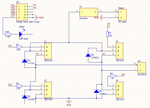stoyanoff
Full Member level 4
No! The problem is I`ve burnt someway the river. I changed them with new and now every thing is OK. Another thing! I was using the charger of an electrical screw driver for 18V power supply, but it`s an impuls power supply. I think this causes the distrotions on the exit. I`ll replace in with something else. i`ve increased the power supply of the IR2110 to 18V because I`d replaced the bootstrap diod with new one which takes more voltage to work (1.7V). I thought my power supply is not enough and I`ve increased it.
I`ll make this changes and I`ll write about the result
I`ll make this changes and I`ll write about the result



